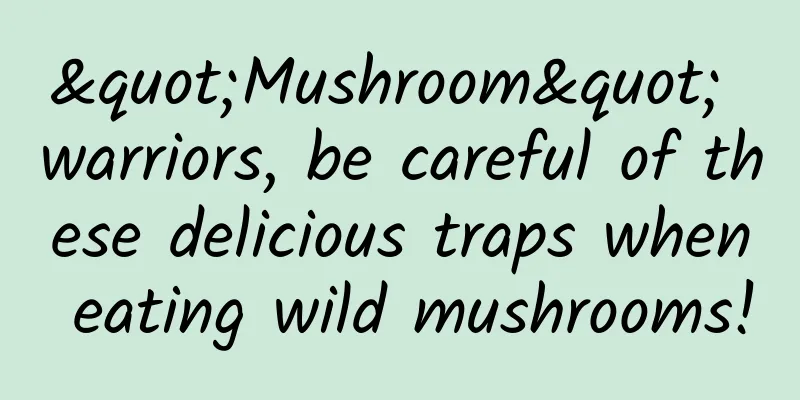"Mushroom" warriors, be careful of these delicious traps when eating wild mushrooms!

|
As warm and humid air flows into Yunnan, it is the season for mushrooms to grow all over the mountains. "Sounds like goose feet, tastes like honey, smooth like shredded mustard without astringency", wild mushrooms, a delicacy given to us by nature, with its rich taste and unique flavor, have stimulated the taste buds of diners from ancient times to the present. However, while enjoying this gift from nature, we must also be alert to the hidden risks - wild mushroom poisoning. So how can foodies who are going to Yunnan to taste mushrooms better understand and prevent this risk? Risks of Eating Wild Mushrooms There are many kinds of wild mushrooms, some of which are poisonous. These poisonous mushrooms are often similar in appearance to non-toxic mushrooms and difficult to distinguish, so poisoning incidents caused by eating poisonous mushrooms by mistake occur from time to time. The main causes of wild mushroom poisoning include: accidentally eating poisonous mushrooms; improper processing and handling; polluted growing environment; allergies, etc. Accidentally eating poisonous mushrooms is the most common cause of poisoning. Some poisonous mushrooms are similar in appearance to non-toxic mushrooms and are easily confused. In addition, even edible wild mushrooms can cause poisoning if they are not processed properly, such as cooking for too short a time to destroy the toxins and not washing them carefully. Symptoms and types of wild mushroom poisoning The symptoms of wild mushroom poisoning vary. Depending on the type of poisoning, they can be divided into gastroenteritis, neuropsychiatric, hemolytic, photoallergic dermatitis, and multiple organ damage types1. " Gastroenteritis type" Generally, the incubation period is short, and the poisoned usually experience nausea, vomiting, abdominal pain, watery diarrhea, general weakness and other symptoms within 10 minutes to 2 hours after eating the poisonous fungus. It is usually not accompanied by fever. This is the most common type of poisoning in clinical practice, and the clinical symptoms are less specific. However, if it is not identified and treated in time, severe cases will lead to dehydration and electrolyte disorders, causing peripheral circulatory failure and endangering life. " Neuropsychiatric " The incubation period is short. Shortly after the onset of gastroenteritis symptoms such as nausea, vomiting, and dizziness, symptoms such as mental excitement, mental confusion, and mental depression will occur. Physical signs include pupil constriction, increased salivation, and staggering gait, accompanied by irritability, auditory hallucinations, visual hallucinations, delirium, and other strange behaviors. A few people will also have symptoms similar to schizophrenia. After ingestion of some poisonous fungi such as the leopard-spotted amanita phalloides, symptoms of vagal nerve excitement, such as sweating and bradycardia, will occur. " Hemolytic" 6 to 12 hours after eating the poisonous fungi, the poisoned person will have symptoms such as anemia and liver enlargement in addition to gastroenteritis. " Multiple organ damage " This type of poisoning develops slowly, usually 10 to 30 hours after eating the poisonous fungus. The victim first shows symptoms of gastroenteritis, and then gradually develops damage to multiple organs such as the liver, brain, heart, and kidneys. The liver is the most seriously damaged, and jaundice and pain in the liver area may occur, followed by convulsions, lethargy, and even coma. If the poisoning is severe and not intervened in time, it will cause great harm to the human body, causing multiple organ failure, shock, and even death2. " Photoallergic dermatitis type " Toxic fungi such as leaf-shaped ear fungus contain photoallergenic toxins. If accidentally ingested, symptoms similar to solar dermatitis may occur, such as facial redness, swelling, burning sensation, and tingling pain. In severe cases, breathing difficulties may occur due to airway edema. Prevention and treatment of wild mushroom poisoning The prevention and treatment of wild mushroom poisoning is a systematic project that needs to be approached from multiple aspects. Raising awareness Strengthen publicity and education on wild mushroom poisoning to raise public awareness of wild mushroom poisoning and preventive measures. Especially in the season when wild mushrooms grow vigorously, people should be reminded to take precautions. When picking wild mushrooms, choose familiar, non-toxic varieties. It is best not to pick wild mushrooms that are difficult to identify. In addition, avoid picking wild mushrooms in heavily polluted areas to avoid accidentally eating poisonous mushrooms. Picking correctly Processing When processing wild mushrooms, you must strictly follow the standard operation. The wild mushrooms must be cooked thoroughly to completely decompose the toxins. At the same time, you must pay attention to keeping the processing environment clean and hygienic, and thoroughly clean the kitchen utensils that have been boiled and touched by raw mushrooms. Seek medical attention promptly If you suspect that you have symptoms of wild mushroom poisoning, you should call the emergency number immediately. While waiting for the ambulance, you can take some simple self-help measures, such as drinking a lot of warm salt water, inducing vomiting, etc., to reduce the absorption of toxins to a certain extent. But please note that if the patient is unconscious or has fainted, the above methods cannot be used to prevent the patient from suffocating. Be sure to wait for professional medical treatment. Treatment for wild mushroom poisoning The treatment methods for wild mushroom poisoning mainly include vomiting, gastric lavage, catharsis, symptomatic and supportive treatment, antidote treatment and dialysis therapy3. Induce vomiting, gastric lavage, and catharsis For conscious poisoned people, vomiting, gastric lavage and catharsis can be carried out in time. Vomiting can stimulate the throat to induce vomiting reflex, gastric lavage can be done by injecting water or drug solution into the stomach through a stomach tube for cleaning, and catharsis can promote the discharge of toxins in the intestine through enema or oral laxatives. Symptomatic and supportive treatment Actively correct the imbalance of water, electrolytes and acid-base balance, and promote the excretion of toxins by diuresis. Provide liver protection support treatment for patients with liver damage. Adrenal cortex hormone has a certain therapeutic effect on acute hemolysis, toxic liver damage, toxic myocarditis, etc. Those with obvious bleeding should be transfused with fresh blood or plasma and supplemented with necessary coagulation factors. Those with mental symptoms or convulsions should be given sedative or anticonvulsant treatment. Antidote treatment Different antidotes can be selected for treatment depending on the type of poisoning. For example, atropine or penehyclidine hydrochloride are suitable for poisoning with muscarinic mushrooms, and sulfhydryl complexing agents have a certain effect on poisoning with liver-damaging mushrooms, etc.4. Dialysis therapy Dialysis therapy can be used to treat patients with critical renal failure or those who have some effect on the clearance of most muscarinic alkaloids. Wild mushroom poisoning is a serious public health issue that requires our high attention. Through strengthening publicity and education, correct picking and processing, timely medical treatment and scientific treatment methods, we can effectively prevent and deal with the risk of wild mushroom poisoning. While enjoying the deliciousness and nutrition brought by wild mushrooms, we should also always pay attention to our own health and safety. References: [1]Wennig R, Eyer F, Schaper A, Zilker T, Andresen-Streichert H. Mushroom Poisoning. Dtsch Arztebl Int. 2020 Oct 16;117(42):701-708. doi: 10.3238/arztebl.2020.0701. PMID: 33559585; PMCID: PMC7868946. [2]Yang LF, Zhu LP, Li YT, Zhong XB, Chen ZG, Leung KKY, Hon KL. Liver and kidney toxicity caused by wild mushroom poisoning. Hong Kong Med J. 2022 Jun;28(3):271.e1-271.e2. doi: 10.12809/hkmj208892. PMID: 35765737. [3] Govorushko S, Rezaee R, Dumanov J, Tsatsakis A. Poisoning associated with the use of mushrooms: A review of the global pattern and main characteristics. Food Chem Toxicol. 2019 Jun;128:267-279. doi:10.1016/j.fct.2019.04.016. Epub 2019 Apr 14. PMID: 30995515. [4] French LK, Hendrickson RG, Horowitz BZ. Amanita phalloides poisoning. Clin Toxicol (Phila). 2011 Feb;49(2):128-9. doi: 10.3109/15563650.2011.557663. PMID: 21370953. Author: Wen Jia, Ph.D. in Anesthesiology, Capital Medical University Editor: Wang Xue END |
<<: Be careful! A "cold" may be fulminant myocarditis
Recommend
There are more and more strange-looking dogs, some even look like aliens. Why is this happening?
There are many kinds of pet dogs nowadays, with s...
How can the maternal and infant community APP products make good plans for the new year?
This task is usually led by the product director ...
How to avoid motion sickness? Check out this motion sickness rescue guide
Literature shows that about one-third of the worl...
I fell in the metaverse, it hurts so much!
The baby left the mother's body and came into...
Wang Xuehong is obsessed with VR: HTC CEO may fall into industry misunderstanding
At the recently concluded MWC2016, VR once again ...
4K smart TVs are not worthy of their name and ecological shortcomings restrict large-scale application
In the past two months, the smart TV market has b...
Xiaohongshu Operation Guide
Let’s take a look at how to achieve conversion ra...
Kuaishou announces full-link support for HDR video, enabling HDR video creation and consumption
Recently, Kuaishou APP announced that it will pro...
Good products do not mean good sales. Sony TV has been losing money for ten years.
Whenever Sony is mentioned, its fans always assoc...
Nanchong SEO training: How to identify the quality of website articles
For website optimization, both the inside and out...
China's first autonomous driving platoon road test group standard approved, KargoBot takes the lead in compiling
Recently, Didi's self-driving freight KargoBo...
"Super sweet potato" in the sand: although it is very earthy, it is a "smooth artifact"!
Want to find a cheap and easy-to-use "smooth...
Will eating carrots often make you black? Answer: You don’t eat enough to turn black!
Produced by: Science Popularization China Author:...
Vivo Z6 is a performance pioneer, bringing 5G mobile phones into the 2,000 yuan range with a quasi-flagship attitude
Since 2018, many mobile phone manufacturers have ...
These 5 types of cancer may be caused by what you eat!
This article was reviewed by Guo Xiaoqiang, a pop...









